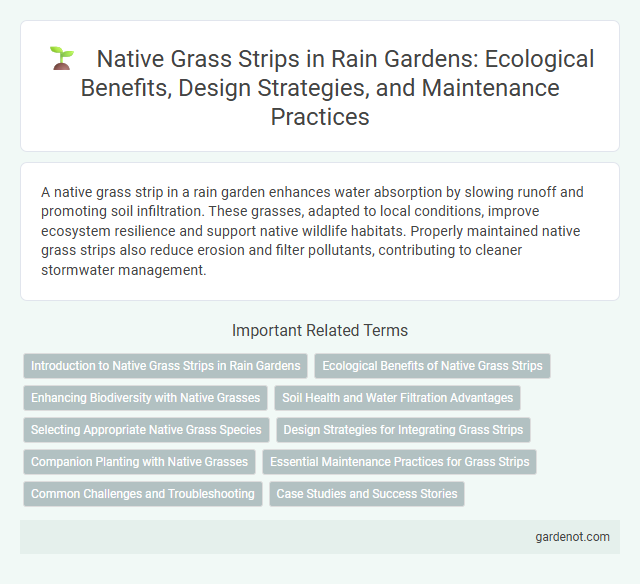A native grass strip in a rain garden enhances water absorption by slowing runoff and promoting soil infiltration. These grasses, adapted to local conditions, improve ecosystem resilience and support native wildlife habitats. Properly maintained native grass strips also reduce erosion and filter pollutants, contributing to cleaner stormwater management.
Introduction to Native Grass Strips in Rain Gardens
Native grass strips in rain gardens play a crucial role in managing stormwater runoff by filtering pollutants and reducing soil erosion. These strips typically consist of deep-rooted grasses that enhance water infiltration and support local biodiversity. Integrating native grass strips into rain garden design improves overall ecosystem health while providing aesthetic and environmental benefits.
Ecological Benefits of Native Grass Strips
Native grass strips enhance biodiversity by providing habitat for pollinators, birds, and beneficial insects, fostering ecological balance within rain garden ecosystems. Their deep root systems improve soil structure, increase water infiltration, and reduce erosion, promoting healthy groundwater recharge. These strips also filter pollutants and excess nutrients from runoff, contributing to improved water quality and sustainable stormwater management practices.
Enhancing Biodiversity with Native Grasses
Native grass strips in rain gardens play a crucial role in enhancing biodiversity by providing habitat and food sources for pollinators and beneficial insects. These grasses support soil health through deep root systems that improve water infiltration and prevent erosion. Incorporating species like switchgrass and little bluestem promotes diverse plant communities and strengthens ecosystem resilience.
Soil Health and Water Filtration Advantages
Native grass strips enhance soil health by increasing organic matter and promoting microbial diversity, which improves soil structure and nutrient cycling. Their dense root systems facilitate effective water infiltration, reducing surface runoff and filtering pollutants such as sediments, nutrients, and heavy metals. These natural filtration processes contribute to improved groundwater quality and overall ecosystem resilience.
Selecting Appropriate Native Grass Species
Selecting appropriate native grass species for rain garden strips enhances water absorption and soil stabilization by matching plant characteristics to local climate and soil conditions. Species such as little bluestem (Schizachyrium scoparium), switchgrass (Panicum virgatum), and blue grama (Bouteloua gracilis) are effective for their deep root systems and drought tolerance. Proper selection increases biodiversity, reduces maintenance needs, and improves the rain garden's overall ecological function.
Design Strategies for Integrating Grass Strips
Design strategies for integrating native grass strips in rain gardens emphasize selecting deep-rooted species like little bluestem or switchgrass to enhance soil infiltration and stabilize erosion-prone areas. Placement should follow natural water flow patterns, creating linear barriers that slow runoff and promote sediment deposition. Incorporating diverse grass heights and textures increases habitat complexity and improves pollutant filtration efficiency.
Companion Planting with Native Grasses
Native grass strips enhance rain garden functionality by improving soil stability and increasing water infiltration. Companion planting with native grasses such as little bluestem (Schizachyrium scoparium) and switchgrass (Panicum virgatum) promotes biodiversity while suppressing invasive species. These grasses, combined with flowering perennials, create a resilient ecosystem that supports pollinators and helps manage stormwater efficiently.
Essential Maintenance Practices for Grass Strips
Native grass strips require regular mowing at heights of 3 to 4 inches to maintain healthy growth and prevent invasive species establishment. Periodic inspections for weed infestations and prompt removal help sustain plant diversity and soil stability. Soil aeration and occasional reseeding with native species enhance root development and resilience against erosion in rain garden settings.
Common Challenges and Troubleshooting
Native grass strips in rain gardens often face challenges such as poor establishment due to compacted soil, uneven water distribution, and competition from invasive species. Troubleshooting involves soil aeration to improve drainage, strategic planting to ensure even moisture, and regular weeding to control invasive plants. Monitoring vegetation health and adjusting irrigation practices can enhance survival and promote native grass growth.
Case Studies and Success Stories
Native grass strips in rain garden installations have demonstrated significant success in improving stormwater management and enhancing local biodiversity. Case studies from urban areas in the Midwest reveal that these strips effectively reduce runoff by up to 40% and increase infiltration rates, promoting groundwater recharge. Success stories highlight long-term maintenance ease and the thriving ecosystems supported by native grasses, showcasing their value in sustainable landscape design.
Native grass strip Infographic

 gardenot.com
gardenot.com